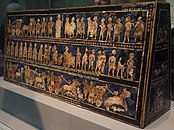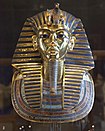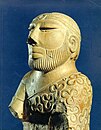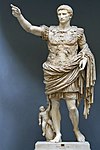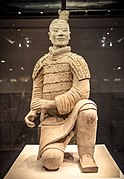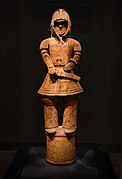
A | B | C | D | E | F | G | H | CH | I | J | K | L | M | N | O | P | Q | R | S | T | U | V | W | X | Y | Z | 0 | 1 | 2 | 3 | 4 | 5 | 6 | 7 | 8 | 9
| Ancient history |
|---|
| Preceded by prehistory |
|
| Part of a series on |
| Human history |
|---|
| ↑ Prehistory (Stone Age) (Pleistocene epoch) |
| ↓ Future |
Ancient history is a time period from the beginning of writing and recorded human history through late antiquity. The span of recorded history is roughly 5,000 years, beginning with the development of Sumerian cuneiform script and continuing until the expansion of Islam in late antiquity. Ancient history covers all continents inhabited by humans in the period 3000 BC – AD 750. The three-age system periodizes ancient history into the Stone Age, the Bronze Age, and the Iron Age, with recorded history generally considered to begin with the Bronze Age. The start and end of the three ages vary between world regions. In many regions the Bronze Age is generally considered to begin a few centuries prior to 3000 BC, while the end of the Iron Age varies from the early first millennium BC in some regions to the late first millennium AD in others.
During the time period of ancient history, the world population was already exponentially increasing due to the Neolithic Revolution, which was in full progress. While in 10,000 BC, the world population stood at 2 million, it rose to 45 million by 3,000 BC. By the Iron Age in 1000 BC, the population had risen to 72 million. By the end of the ancient period in AD 500, the world population is thought to have stood at 209 million. In 10,500 years, the world population increased by 100 times.[1]
Prehistory
Prehistory is the period before written history. Most of our knowledge of that period comes from the work of archaeologists.[2] Prehistory is often known as the Stone Age, and is divided into the Paleolithic (earliest), Mesolithic, and Neolithic.[3]
The early human migrations in the Lower Paleolithic saw Homo erectus spread across Eurasia 1.8 million years ago.[4] Evidence for the use of fire has been dated as early as 1.8 million years ago, a date which is contested,[5] with generally accepted evidence for the controlled use of fire dating to 780,000 years ago. Actual use of hearths first appears 400,000 years ago.[6] Dates for the emergence of Homo sapiens (modern humans) range from 250,000[7] to 160,000 years ago,[8] with the varying dates being based on DNA studies[7] and fossils respectively.[8] Some 50,000 years ago, Homo sapiens migrated out of Africa. They reached Australia about 45,000 years ago, southwestern Europe about the same time, southeastern Europe and Siberia around 40,000 years ago, and Japan about 30,000 years ago. Humans migrated to the Americas about 15,000 years ago.[9]
Evidence for agriculture emerges in about 9000 BC in what is now eastern Turkey and spread through the Fertile Crescent.[10] Settlement at Göbekli Tepe began around 9500 BC and may have the world's oldest temple.[11] The Nile River Valley has evidence of sorghum and millet cultivation starting around 8000 BC and agricultural use of yams in Western Africa perhaps dates to the same time period. Cultivation of millet, rice, and legumes began around 7000 BC in China. Taro cultivation in New Guinea dates to about 7000 BC also with squash cultivation in Mesoamerica perhaps sharing that date.[10] Animal domestication began with the domestication of dogs, which dates to at least 15,000 years ago, and perhaps even earlier. Sheep and goats were domesticated around 9000 BC in the Fertile Crescent, alongside the first evidence for agriculture. Other animals, such as pigs and poultry, were later domesticated and used as food sources.[12] Cattle and water buffalo were domesticated around 7000 BC and horses, donkeys, and camels were domesticated by about 4000 BC. All of these animals were used not only for food, but to carry and pull people and loads, greatly increasing human ability to do work. The invention of the simple plough by 6000 BC further increased agricultural efficiency.[13]
Metal use in the form of hammered copper items predates the discovery of smelting of copper ores, which happened around 6000 BC in western Asia and independently in eastern Asia before 2000 BC. Gold and silver use dates to between 6000 and 5000 BC. How to make metal alloys began with bronze in about 3500 BC in Mesopotamia and was developed independently in China by 2000 BC.[14] Pottery developed independently throughout the world,[15] with fired pots appearing first among the Jomon of Japan and in West Africa at Mali.[16] Sometime between 5000 and 4000 BC the potter's wheel was invented.[15] By 3000 BC,[17] the pottery wheel was adapted into wheeled vehicles which could be used to carry loads further and easier than with human or animal power alone.[15]
Writing developed separately in five different locations in human history: Mesopotamia, Egypt, India, China, and Mesoamerica.[18] By 3400 BC, "proto-literate" cuneiform spread in the Middle East.[19] Egypt developed its own system of hieroglyphs by about 3200 BC.[18] By 2800 BC the Indus Valley civilization had developed its Indus script, which remains undeciphered.[20] Chinese Characters were independently developed in China during the Shang Dynasty in the form of the Oracle Bone Script dating to the period 1600 to 1100 BC.[21] Writing in Mesoamerica dates to 600 BC with the Zapotec civilization.[22]
History by region
West Asia
The ancient Near East is considered the cradle of civilization.[23] It was the first to practice intensive year-round agriculture;[citation needed] created one of the first coherent writing systems,[18] invented the potter's wheel and then the vehicular wheel,[15] created the first centralized governments,[24] law codes[25] and empires,[26] as well as displaying social stratification,[23] slavery,[25] and organized warfare.[27] It began the study of the stars and the sciences of astronomy and mathematics.[28]

Mesopotamia
Mesopotamia is the site of some of the earliest known civilisations in the world.[29] Agricultural communities emerged in the area with the Halaf culture around 8000 BC and continued to expand through the Ubaid period around 6000 BC.[30] Cities began in the Uruk period (4000–3100 BC) and expanded during the Jemdet Nasr (3100–2900 BC) and Early Dynastic (2900–2350 BC) periods.[31] The surplus of storable foodstuffs created by this economy allowed the population to settle in one place instead of migrating after crops and herds. It also allowed for a much greater population density, and in turn required an extensive labour force and division of labour.[16] This organization led to the necessity of record keeping and the development of writing.[32]
Babylonia was an Amorite state in lower Mesopotamia (modern southern Iraq),[33] with Babylon as its capital. Babylonia emerged when Hammurabi created an empire out of the territories of the former kingdoms of Sumer and Akkad.[33]
The Neo-Babylonian Empire, or Chaldea, was Babylonia from the 7th and 6th centuries BC.[34] Under the reign of Nebuchadnezzar II, it conquered Jerusalem. This empire also created the Hanging Gardens of Babylon and the still-surviving Ishtar Gate as architectural embellishments of its capital at Babylon.[35]
Akkad was a city and its surrounding region near Babylon. Akkad also became the capital of the Akkadian Empire.[36] Despite an extensive search, the precise site has never been found. Akkad reached the height of its power between about 2330 and 2150 BC, following the conquests of King Sargon of Akkad.[36] Through the spread of Sargon's empire, the language of Akkad, known as Akkadian from the city, spread and replaced the Sumerian language in Mesopotamia and eventually by 1450 BC was the main language of diplomacy in the Near East.[37]
Assyria was originally a region on the Upper Tigris, where a small state was created in the 19th century BC.[34] The capital was at Assur, which gave the state its name.[38] Later, as a nation and empire that came to control all of the Fertile Crescent, Egypt and much of Anatolia, the term "Assyria proper" referred to roughly the northern half of Mesopotamia (the southern half being Babylonia), with Nineveh as its capital. The Assyrian kings controlled a large kingdom at three different times in history. These are called the Old (20th to 18th centuries BC), Middle (14th to 11th centuries BC), and Neo-Assyrian (9th to 7th centuries BC) kingdoms, or periods.[39]
Mitanni was a Hurrian empire in northern Mesopotamia founded around 1500 BC. The Mitanians conquered and controlled Assyria until the 14th century BC while contending with Egypt for control of parts of modern Syria. Its capital was Washukanni, whose precise location has not been determined by archaeologists.[40]
Iranian peoples
The Medes and Persians were peoples who had appeared in the Iranian plateau around 1500 BC.[41] Both peoples spoke Indo-European languages and were mostly pastoralists with a tradition of horse archery.[42] The Medes established their own Median Empire by the 6th century BC, having defeated the Neo-Assyrian Empire with the Chaldeans in 614 BC.[35]
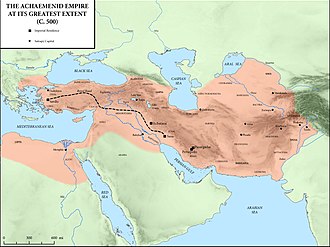
The Achaemenid Empire was founded by Cyrus the Great, who first became king of the Persians, then conquered the Medes, Lydia, and Babylon by 539 BC. The empire built on earlier Mesopotamian systems of government to govern their large empire. By building roads, they improved both the ability to send governmental instructions throughout their lands as well as improving the ability of their military forces to be deployed rapidly. Increased trade and upgraded farming techniques increased wealth, but also exacerbated inequalities between social classes. The empire's location at the centre of trading networks spread its intellectual and philosophical ideas throughout a wide area, and its religion, while not itself spreading far, had an impact on later religions such as Christianity, Islam, and Judaism.[42] Cyrus' son Cambyses II conquered Egypt, while a later emperor, Darius the Great, expanded the empire to the Indus River, creating the largest empire in the world to that date.[43] But Darius and his son Xerxes I failed to expand into Greece, with expeditions in 490 and 480 BC eventually failing.[44] The Achaemenid dynasty and empire fell to Alexander the Great by 330 BC, and after Alexander's death, much of the area previously ruled by the Cyrus and his successors was ruled by the Seleucid dynasty.[45]

Parthia was an Iranian civilisation situated in the northeastern part of modern Iran. Their power was based on a combination of military power based on heavy cavalry with a decentralised governing structure based on a federated system.[46] The Parthian Empire was led by the Arsacid dynasty,[citation needed] which by around 155 BC under Mithradates I had mostly conquered the Seleucid Empire. Parthia had many wars with the Romans, but it was rebellions within the empire that ended it in the 3rd century AD.[46]
The Sasanian Empire began when the Parthian Empire ended in AD 224. Their rulers claimed the Achaemenids as ancestors and set up their capital at Ctesiphon in Mesopotamia. Their period of greatest military expansion occurred under Shapur I, who by the time of his death in AD 272 had defeated Roman imperial armies and set up buffer states between the Sasanians and Roman Empires. After Shapur, the Sasanians were under more pressure from the Kushans to their east as well as the Roman then Byzantine Empire to its west. However, the Sasanians rebuilt and founded numerous cities and their merchants traveled widely and introduced crops such as sugar, rice, and cotton into the Iranian plateau. But in AD 651, the last Sassanid emperor was killed by the expanding Islamic Arabs.[47]
Hittites
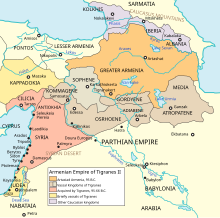
The Hittites first came to Anatolia about 1900 BC and during the period 1600-1500 they expanded into Mesopotamia where they adopted the cuneiform script to their Indo-European language. By 1200 their empire stretched to Phoenicia and eastern Anatolia. They improved two earlier technologies from Mesopotamia and spread these new techniques widely – improved iron working and light chariots with spoked wheels in warfare. The Hittites introduced the casting of iron with molds and then hammering it which enabled weapons and tools to be made stronger and also cheaper. Although chariots had been used previously, the use of spoked wheels allowed the chariots to be much lighter and more maneuverable.[48] In 1274 BC the Hittites clashed with the Egyptians at the Battle of Kadesh, where both sides claimed victory. In 1207 the Hittite capital of Hattusa was sacked, ending the Hittite Empire.[49]
Israel

Israel and Judah were related Iron Age kingdoms of the ancient Levant and had existed during the Iron Ages and the Neo-Babylonian, Persian and Hellenistic periods. The name Israel first appears in the stele of the Egyptian pharaoh Merneptah around 1209 BC.[50] This "Israel" was a cultural and probably political entity of the central highlands, well enough established to be perceived by the Egyptians as a possible challenge to their hegemony, but an ethnic group rather than an organised state.[51]
Israel had emerged by the middle of the 9th century BC, when the Assyrian King Shalmaneser III named "Ahab the Israelite" among his enemies at the battle of Qarqar (853). Judah emerged somewhat later than Israel, probably during the 9th century BC, but the subject is one of considerable controversy.[52] Israel came into conflict with the Assyrians, who conquered Israel in 722 BC. The Neo-Babylonian Empire did the same to Judah in 586. After both conquests, the conquering forces deported many of the inhabitants to other regions of their respective empires.[53]
Following the fall of Babylon to the Persian Empire, Cyrus the Great allowed the rebuilding of the temple at Jerusalem,[54] and some of the exiles from Judah returned to Judea,[55] where they remained under Persian rule until the Maccabean revolt led to independence during Hellenistic period until Roman conquest.[56]
Phoenicia
Phoenicia was an ancient civilisation centered in the north of ancient Canaan, with its heartland along the coastal regions of modern-day Lebanon, Syria and Israel. Phoenician civilisation was an enterprising maritime trading culture that spread across the Mediterranean between the period of 1550 to 300 BC.[57] One Phoenician colony, Carthage, ruled an empire in the Western Mediterranean until being defeated by Rome in the Punic Wars.[58] The Phoenicians invented the Phoenician alphabet, the forerunner of the modern alphabet still in use today.[59]
Arabia
The history of Pre-Islamic Arabia before the rise of Islam in the AD 630s is not known in great detail.[60] Archaeological exploration in the Arabian peninsula has been sparse; indigenous written sources are limited to the many inscriptions and coins from southern Arabia. Existing material consists primarily of written sources from other traditions (such as Egyptians, Greeks, Persians, Romans, etc.) and oral traditions later recorded by Islamic scholars.[citation needed] A number of small kingdoms existed in Arabia from around AD 100 to perhaps about AD 400.[60]
Africa
Afro-Asiatic Africa
Carthage
Carthage was founded around 814 BC by Phoenician settlers.[58] Ancient Carthage was a city-state that ruled an empire through alliances and trade influence that stretched throughout North Africa and modern Spain.[61] At the height of the city's influence, its empire included most of the western Mediterranean.[58] The empire was in a constant state of struggle with the Roman Republic, which led to a series of conflicts known as the Punic Wars. After the third and final Punic War, Carthage was destroyed and then occupied by Roman forces. Nearly all of the territory held by Carthage fell into Roman hands.[62]
Egypt

Ancient Egypt was a long-lived civilisation geographically located in north-eastern Africa. It was concentrated along the middle to lower reaches of the Nile River,[63] reaching its greatest extent during the 2nd millennium BC, which is referred to as the New Kingdom period.[64] It reached broadly from the Nile Delta in the north, as far south as Jebel Barkal at the Fourth Cataract of the Nile. Extensions to the geographical range of ancient Egyptian civilisation included, at different times, areas of the southern Levant, the Eastern Desert and the Red Sea coastline, the Sinai Peninsula,[65] and the Western Desert (focused on the several oases).
Ancient Egypt developed over at least three and a half millennia.[63] It began with the incipient unification of Nile Valley polities around 3100 BC, traditionally under Menes.[66] The civilisation of ancient Egypt was characterised primarily by intensive agricultural use of the fertile Nile Valley;[67] the use of the Nile itself for transportation;[68] the development of writing systems – first hieroglyphs and then later hieratic and other derived scripts – and literature;[69] the organisation of collective projects such as the pyramids;[70] trade with surrounding regions;[71] and a polytheistic religious tradition that included elaborate funeral customs including mummification.[72] Overseeing these activities were a socio-political and economic elite[73] under the figure of a (semi)-divine ruler from a succession of ruling dynasties.[74]
Ancient Egyptian history is divided across various periods, beginning with the Old Kingdom, which saw pyramid building on a large scale. After 2100 BC, the Old Kingdom dissolved into smaller states during the First Intermediate Period, which lasted about 100 years.[75] The Middle Kingdom began around 2000 BC with the reunification of Egypt under pharoes ruling from Thebes. The Middle Kingdom ended with the conquest of northern Egypt by the Hyksos around 1650 BC.[76] The Hyksos were expelled from Egypt and the land was reunited in the New Kingdom around 1550 BC. This period lasted until about 1000 BC, and saw Egypt expand its borders into Palestine and Syria. The Third Intermediate Period was marked by the rule of priests as well as the conquest of Egypt by Nubian kings and then later Assyria, Persia, and Macedonians.[64]
Nubia

The Ta-Seti kingdom in Nubia to the south of Egypt was conquered by Egyptian rulers around 3100 BC, but by 2500 BC the Nubians had created a new kingdom further south, known as the Kingdom of Kush, centred on the upper Nile with a capital at Kerma.[77] In the Egyptian New Kingdom period, Kush once more was conquered by Egypt. However, by 1100 BC a new kingdom of Kush had formed, with a capital at Napata. Nubian rulers conquered Egypt around 760 BC and retained control for about a century.[78]
Aksum and ancient Ethiopia

The Kingdom of Aksum was an important trading nation in northeastern Africa centered in present-day Eritrea and northern Ethiopia, it existed from approximately AD 100 to 940, growing from the Iron Age proto-Aksumite period around the 4th century BC to achieve prominence by the 1st century AD.[79] The Kingdom of Aksum at its height by the early 6th-century AD extended through much of modern Ethiopia and across the Red Sea to Arabia. The capital city of the empire was Aksum, now in northern Ethiopia.[80]
Niger-Congo Africa
Nok culture
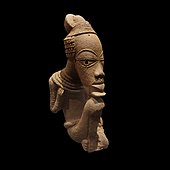
The Nok culture appeared in Nigeria around 1000 BC and mysteriously vanished around AD 200. The civilisation's social system is thought to have been highly advanced. The Nok civilisation was considered to be the earliest sub-Saharan producer of life-sized Terracotta which have been discovered by archaeologists. The Nok also used iron smelting that may have been independently developed.[81]
Sahel
Djenné-Djenno
The civilisation of Djenné-Djenno was located in the Niger River Valley in the country of Mali and is considered to be among the oldest urbanized centers and the best-known archaeology site in sub-Saharan Africa. This archaeological site is located about 3 kilometers (1.9 miles) away from the modern town and is believed to have been involved in long-distance trade and possibly the domestication of African rice. The site is believed to exceed 33 hectares (82 acres); however, this is yet to be confirmed with extensive survey work. With the help of archaeological excavations mainly by Susan and Roderick McIntosh, the site is known to have been occupied from 250 BC to AD 900. The city is believed to have been abandoned and moved where the current city is located due to the spread of Islam and the building of the Great Mosque of Djenné. Previously, it was assumed that advanced trade networks and complex societies did not exist in the region until the arrival of traders from Southwest Asia. However, sites such as Djenné-Djenno disprove this, as these traditions in West Africa flourished long before. Towns similar to that at Djenne-Jeno also developed at the site of Dia, also in Mali along the Niger River, from around 900 BC.
Dhar Tichitt and Oualata
Zdroj:https://en.wikipedia.org?pojem=Ancient_HistoryText je dostupný za podmienok Creative Commons Attribution/Share-Alike License 3.0 Unported; prípadne za ďalších podmienok. Podrobnejšie informácie nájdete na stránke Podmienky použitia.
Antropológia
Aplikované vedy
Bibliometria
Dejiny vedy
Encyklopédie
Filozofia vedy
Forenzné vedy
Humanitné vedy
Knižničná veda
Kryogenika
Kryptológia
Kulturológia
Literárna veda
Medzidisciplinárne oblasti
Metódy kvantitatívnej analýzy
Metavedy
Metodika
Text je dostupný za podmienok Creative
Commons Attribution/Share-Alike License 3.0 Unported; prípadne za ďalších
podmienok.
Podrobnejšie informácie nájdete na stránke Podmienky
použitia.
www.astronomia.sk | www.biologia.sk | www.botanika.sk | www.dejiny.sk | www.economy.sk | www.elektrotechnika.sk | www.estetika.sk | www.farmakologia.sk | www.filozofia.sk | Fyzika | www.futurologia.sk | www.genetika.sk | www.chemia.sk | www.lingvistika.sk | www.politologia.sk | www.psychologia.sk | www.sexuologia.sk | www.sociologia.sk | www.veda.sk I www.zoologia.sk

